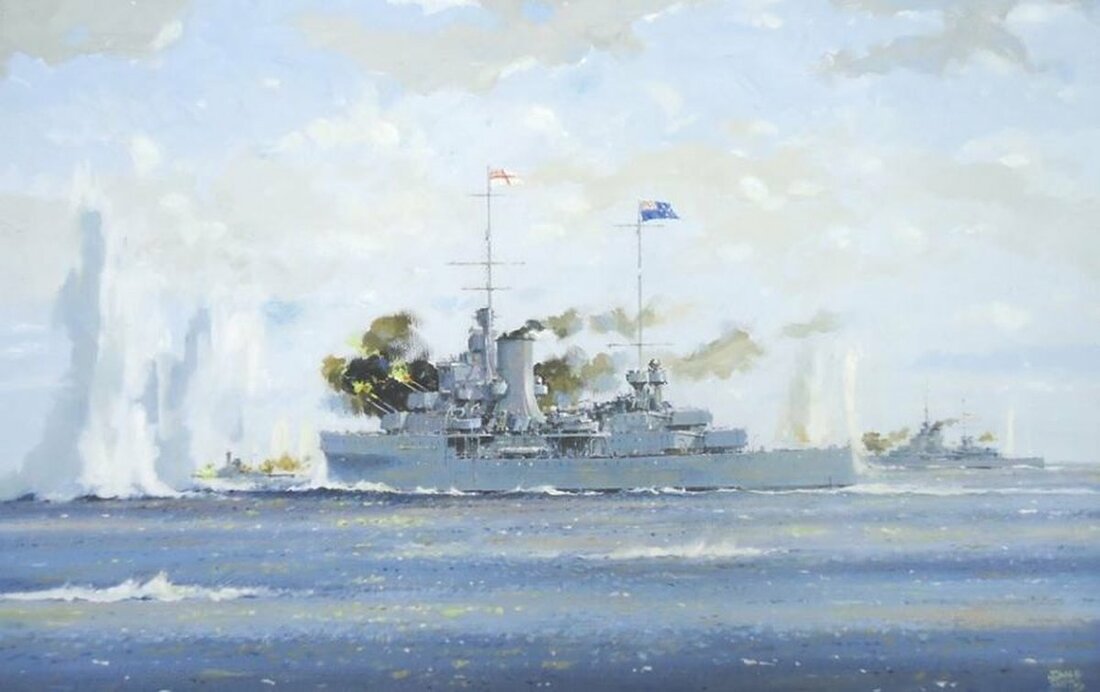Auction: 21002 - Orders, Decorations and Medals
Lot: 279
'In H.M.S. Achilles at about the same time, a similar spirit of courage and fortitude was being displayed. An 11-inch shell had burst just short of the ship, spraying the bridge and gunnery control position with white-hot fragments of metal. Four gunnery ratings were killed, the Captain slightly wounded and the gunnery officer stunned. For a few minutes the secondary control position took over. Then the survivors in the main position resumed, although some of them, including a Royal Marine sergeant, were seriously wounded. Amid a scene of death and destruction, they continued the battle with great coolness, and a seaman boy, with the courage of Jack Cornwell, found time to deny emphatically a rumour that was spreading round the ship that he had been killed … '
High drama aboard H.M.S. Achilles off the River Plate on 13 December 1939; The King's Cruisers, by Gordon Holman, refers.
The Royal Navy L.S. & G.C. Medal awarded to Warrant Electrician J. H. E. Biggs, Royal Navy, who was loaned to the Royal New Zealand Navy on the eve of hostilities and subsequently present in H.M.S Achilles at the celebrated battle of the River Plate in December 1939
Royal Navy L.S. & G.C., G.VI.R., 1st issue (M37939 J. H. Biggs, C.E.A. 2, H.M.S. Achilles), good very fine
John Henry Edward Biggs was born in Portsmouth, Hampshire on 10 January 1908 and entered the Royal Navy as an apprentice in January 1924. By the late 1930s, he had been advanced to Chief Electrical Artificer and was on loan to the Royal New Zealand Navy, serving in the cruiser H.M.S. Achilles.
The River Plate
At the outbreak of the Second World War, Achilles began patrolling the west coast of South America in search of German merchant ships and, on arriving at the Falkland Islands in late October 1939, she was assigned to the South American Division under Commodore Henry Harwood in H.M.S. Exeter.
In the early morning of 13 December 1939, a force consisting of Achilles, Ajax and Exeter detected smoke on the horizon, which was confirmed at 06:16 to be a German pocket battleship, thought to be the Admiral Scheer but which turned out to be Admiral Graf Spee. A fierce battle ensued, at a range of approximately 20 kilometres and, as cited above, Achilles suffered resultant casualties and damage. The range reduced to about four nautical miles at around 0715 and Graf Spee broke off the engagement around 0745 to head for the neutral harbour of Montevideo, which she entered at 2200 that night, having been pursued by Achilles and Ajax all day. Graf Spee was forced by international law to leave within 72 hours. Faced with what he believed to be overwhelming odds, her captain, Hans Langsdorff, famously scuttled his ship rather than risk the lives of his crew. As retold in countless histories, Achilles had played a vital role in the battle by dividing Graf Spee's fire power, in addition to her vital pursuit of the enemy pocket battleship in the wake of the immediate battle. Indeed, Admiral Harwood made special mention of Achilles - and her largely New Zealander crew - in his subsequent despatch, when he stated:
'The honour and pleasure I had in taking one of H.M. ships of the New Zealand Division into action and fully concur with the Commanding Officer of H.M.S. Achilles' remark that 'New Zealand has every reason to be proud of her seamen during their baptism of fire.' '
An ensign flown by Achilles during the battle of the River Plate was donated to Christ Church Cathedral at Port Stanley in the Falkland Islands and is still on display there, hanging on the south wall of the Cathedral.
Beyond the Plate to the Pacific
Following the battle, Achilles returned to Auckland, New Zealand, on 23 February 1940, where she underwent a refit until June. Having then participated in further German raider activities in the South Pacific during 1940, Achilles escorted the first Trans-Tasman commercial convoy from Sydney at the year's end. And it was in the following year - in March - that Biggs was awarded his L.S. & G.C. Medal.
Following Japan's subsequent entry into the war, Achilles joined the ANZAC Squadron in the south-west Pacific. It was here, while operating off Guadalcanal Island with U.S. Navy Task Force 67, that she was attacked by four Japanese aircraft on 5 January 1943: a bomb blew the top off X turret, killing 13 of her crew and she had to return to the U.K. for repairs.
It was at this point, in May 1943, that Biggs's period of attachment to the R.N.Z.N. ended; he was appointed a Warrant Electrician in March 1945.
Subject to 20% VAT on Buyer’s Premium. For more information please view Terms and Conditions for Buyers.
Sold for
£1,000
Starting price
£110







